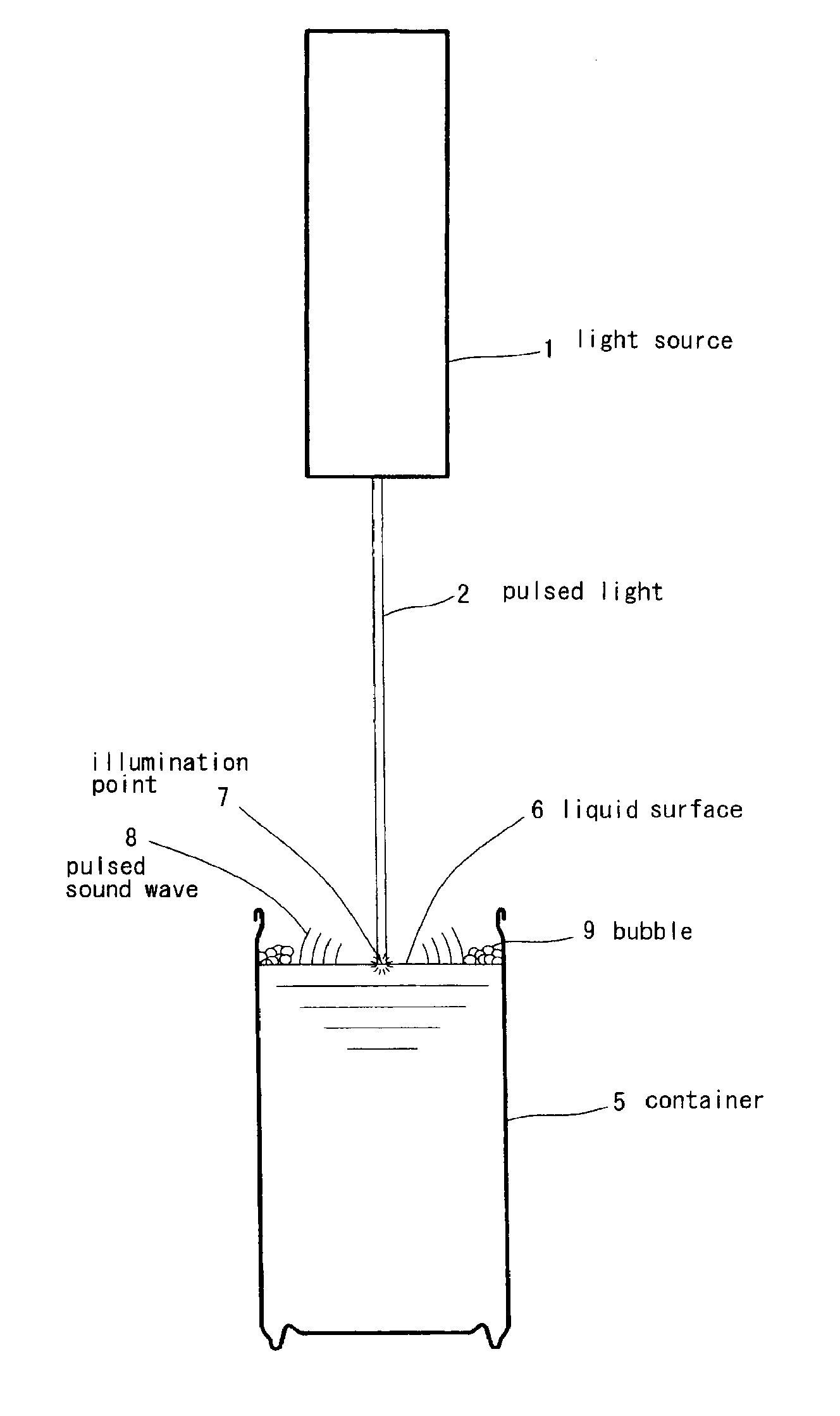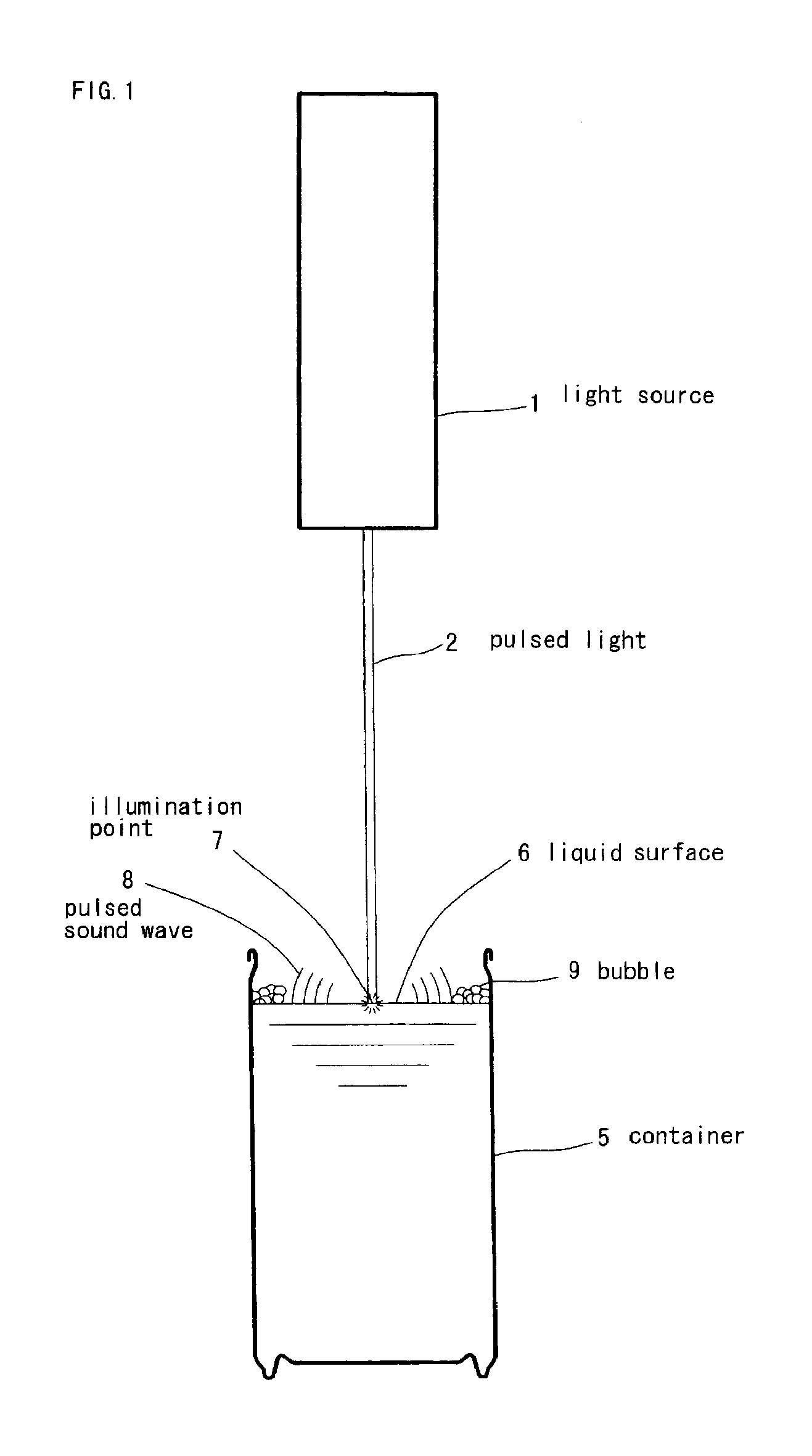Defoaming method
a foaming method and foam technology, applied in the field of foaming methods, can solve the problems of insufficient time available for destroying foam, foam remains, and difficult to decrease the amount of oxygen in the headspace, and achieve the effects of short time, high speed, and reliable generation
- Summary
- Abstract
- Description
- Claims
- Application Information
AI Technical Summary
Benefits of technology
Problems solved by technology
Method used
Image
Examples
example 1
[0068]The basic wave of a Q-switched YAG laser was converged with a convex lens with a focal distance of 300 mm, and the liquid surface of coffee filled in a can (opening diameter 50 mm) with a capacity of 200 g was irradiated. The liquid surface was covered with foam having a height of 10 mm over the entire mouth portion. The laser beam had a wavelength of 1064 nm, a pulse width of 5 ns, a repetition period of 10 Hz, and an average beam power of 1 W. The beam diameter in the focus position was 200 μm, and the beam power density per unit surface area was 5 GW / cm2. When the liquid surface was irradiated with 10 shots of such light beam, the foam was completely destroyed and the entire liquid surface was exposed.
example 2
[0069]The liquid surface of coffee filled in a PET bottle (mouth diameter 20 mm, body diameter 80 mm) with a capacity of 500 mL was irradiated in the same manner as in Example 1. The liquid surface was covered with foam having a height of 15 mm over the entire head space. When the liquid surface was irradiated with 10 shots of such light beam, the foam was completely destroyed and the entire liquid surface was exposed.
[0070]Examples 1, 2 confirmed that the method in accordance with the present invention enables instantaneous defoaming even of coffee beverages on which the bubbles are comparatively difficult to break down and also when the entire liquid surface in the container is covered with foam. Further, foam located on the wall surface circumference of a container is not easy to destroy by the conventional methods, but this foam is also reliably destroyed in the examples. Moreover, as shown in Example 2, defoaming in a narrow-mouth container can be performed as effectively as in...
example 3
[0071]The basic wave (beam diameter 9 mm) of a Q-switched pulsed YAG laser was converged with an aplanat convex lens with a focal distance of 150 mm, the beam was converged 10 mm above the liquid surface of green tea beverage filled in a can (opening diameter about 50 mm) with a capacity of 200 g, and laser induced breakdown (LIB) was generated. Foam with a thickness of about 5 mm remained along the edge with the side wall on the liquid surface of the green tea beverage.
[0072]The laser beam was in a Gaussian mode and had a laser wavelength of 1064 nm, a pulse width of 5 ns, a repetition period of 10 Hz, and an average beam power of 1 W. Thus, the light energy per one pulse was 100 mJ. With one-shot irradiation of the pulse, the entire foam present on the liquid surface was destroyed by the sound wave generated by LIB.
[0073]Further, when the laser beam was converged on the liquid surface under the same conditions, the foam could be completely destroyed at 50 mJ.
PUM
 Login to View More
Login to View More Abstract
Description
Claims
Application Information
 Login to View More
Login to View More - R&D
- Intellectual Property
- Life Sciences
- Materials
- Tech Scout
- Unparalleled Data Quality
- Higher Quality Content
- 60% Fewer Hallucinations
Browse by: Latest US Patents, China's latest patents, Technical Efficacy Thesaurus, Application Domain, Technology Topic, Popular Technical Reports.
© 2025 PatSnap. All rights reserved.Legal|Privacy policy|Modern Slavery Act Transparency Statement|Sitemap|About US| Contact US: help@patsnap.com



